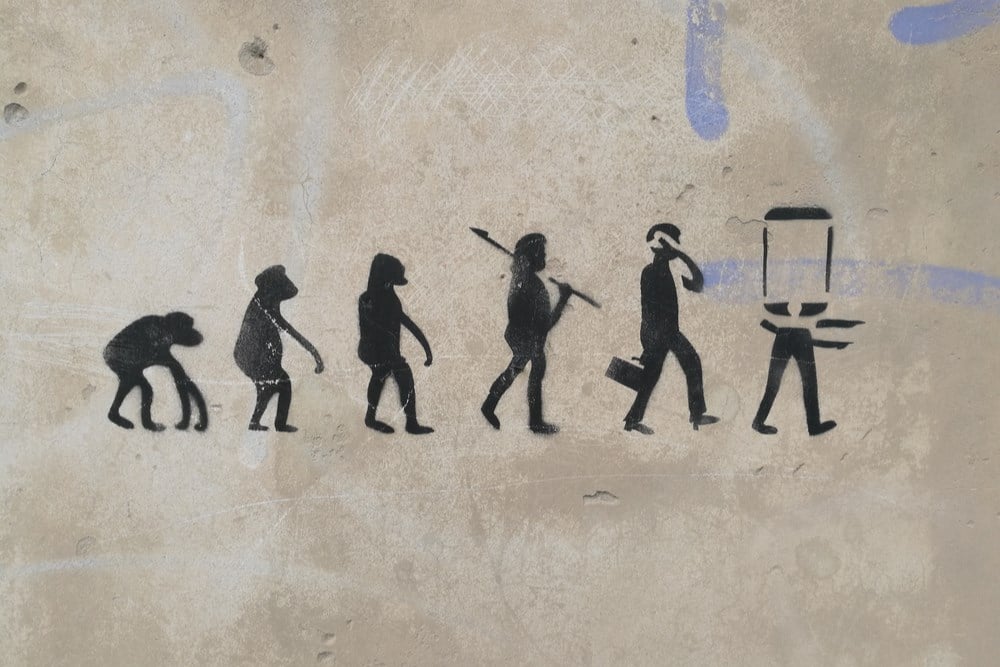Have you ever wondered how sales came into existence…?
In ancient times, there was no money, and people used to live off barter. The idea of exchanging came into existence when one person could not foresee everything in the world and make everything available on their own. People used to give an extra pair of tools or animal skin in exchange for food or clothes.
With time, settlements between people started to grow and the barter system lost its effectiveness as it began to be impossible to fairly measure the value of goods by comparing them with the things in exchange. Then it was time for establishing trade relations between people. Transporting massive grain stocks back and forth to pay for them is far more difficult than lugging a purse full of little coins. This is how money first appeared – as a universal means for determining the worth of things.
Simultaneously, the first retail outlets – markets – began to appear. Previously, sales were made directly in the houses of artisans, where people came to get what they wanted; today, all merchants converged in one square for convenience and speed of service (the population was also rapidly rising). Such open-air markets can be seen as the forerunners of modern marketplaces.
Interesting fact: In 640 B.C., King Alyattes of Lydia introduced the first coins in human history, while the first paper money arrived in China in the VII century. However, it was not until a thousand years later that the latter became widely used throughout the world.
Sales has always been a crucial component of business success, however, sales professionals’ methods and strategies have developed dramatically over time. During the early days of business, sales were essentially transactional, with the vendor focusing on persuading the consumer to make a purchase.
Daniel H. Pink’s publication in Harvard Business Review says, “In the past, salespeople were perceived as persuasive talkers who could close deals through sheer force of personality.” This era was distinguished by high-pressure methods that emphasized persuasion and the seller’s control over the sales process. In his latest book, To Sell is Human: The Surprising Truth About Moving Others, he shares a fresh perspective on the science and art of sales with a blend of survey research, social science, and stories. He says, “In today’s world, we are all salespeople.”
As we are all salespeople at some point in our lives, it is easier to build on this mindset to establish life-long relationships. Relationship selling gained prominence as sales professionals realized the importance of building trust and establishing long-term relationships with customers. According to the best-selling author, sales trainer, and speaker, Tom Hopkins, “Selling is no longer about persuading people to buy; it’s about building relationships that lead to mutually beneficial partnerships.”
The information age and increased consumer awareness have caused a shift in sales strategies. The author of the book SPIN Selling, Neil Rackham, notes, “Consultative selling became a dominant approach as customers sought expertise and guidance from sales professionals.” Instead of only pushing items, salespeople started focusing on understanding client needs, creating customized solutions, and providing value through expertise and insights.
The integration of technology into the sales process in the twenty-first century transformed the way organizations connected with clients. According to a publication in the Harvard Business Review, “Sales organizations are increasingly leveraging data analytics, automation, and artificial intelligence to drive sales effectiveness and efficiency.” Salespeople today have access to massive volumes of data, which allows them to make more educated decisions, tailor interactions, and improve client experiences.
With the rise of social media platforms, sales professionals have recognized the opportunity to engage clients through these channels. According to Jill Rowley, a social selling evangelist, “Social selling is about leveraging your social network to find the right prospects, build trusted relationships, and, ultimately, achieve your sales goals.” Salespeople may now use platforms like LinkedIn and Twitter to develop thought leadership, cultivate relationships, and raise brand awareness.
In today’s business environment, successful sales methods concentrate on putting the customer first. The key to sales success lies in adopting a customer-centric mindset and providing a personalized experience. Sales professionals can personalize their approach, generate value, and encourage long-term customer loyalty by understanding individual preferences, pain areas, and objectives.
This is how sales have evolved over the years from traditional to modern, where customer-centric tactics require convincing approaches. The sales landscape is changing as technology is integrated and client relationships are prioritized. Sales professionals who embrace this transformation will be able to react to changing market dynamics, create tailored experiences, and ultimately drive business success in the ever-competitive global marketplace.
Now that we have had a run-through of the evolution of sales, let’s find out everything that encircles the sales process.
What Is Sales?

It is a transaction that involves services or goods exchanged for a specific sum of money. Businesses have sales organizations that are divided into teams. And these sales teams are frequently developed based on the market location, the product or service being marketed, and the target consumer.
In an interview, Daniel Pink says, “One in every nine Americans works in sales, which means they try to persuade others to buy something. However, more importantly, the remaining 8 in 9 are also in sales. They’re now spending a significant amount of time persuading, influencing, and compelling people to make a transaction – what I call “non-sales selling.”
We all are a big part of sales whether we believe it or not. In reality, we do not like the idea of being a salesman. No matter how much we agree to disagree, this is the era of bringing new perspectives to the business. There is no point in following the iron age processes to follow the pattern, rather it is better to adopt the nature of sales.
He continues by saying, selling has a poor reputation because most of what we know about it emerged in an era of information asymmetry, in which the seller always had more information than the buyer and thus could take advantage of the customer. Today, however, information asymmetry is giving way to something resembling information parity. That has altered the game in ways we have yet to recognize. We are part of a culture where ‘buyer beware’ is applicable to ‘seller beware.’
Forrester conducted a well-known survey of B2B buyers in 2012 and discovered that 74% of business buyers perform more than half of their research online before making an offline purchase. This is a critical metric if your sales staff is actively looking for new prospects or converting inbound sales leads.
That is, you must provide prospects with enough information to allow them to thoroughly investigate your product or service before contacting you. There is no longer any reason to keep information off your website in the expectation that prospects will request it. They most likely will not. Instead, they’ll go to your competitor’s websites to find the information they’re looking for.
When you have a strong online presence where prospects may conduct extensive research before speaking with you, your closing ratio will improve. Given the desire of customers to educate themselves, it should be a goal to provide them with as much information as possible, as quickly as possible.
Eric Feng is one of the world’s most acclaimed sales kickoff speakers and he says, “In the digital world, the customers want you to follow three key trends—they want to be Known, Loved, and Respected.” Customers want to buy on their own time, so the salespeople have to shift their mindset from winning the money to winning the attention. They want to be involved in the buying process with someone who cares for them, so the salespeople have to move from closing a deal to caring about the customer. They want to be respected, so the salespeople have to move beyond the brochure talk to be the trusted authority.
Customers have grown more cautious, and more educated, and as a result, their purchasing decisions have become more complicated. There is a risk-aversion culture. It’s no longer “We know you, so we’ll give you a shot.” People want to see a return on investment and confirmation that what you’re selling will make a difference in their lives.
Today’s business also observes growth in consensus-based decisions, implying that there is no longer a single decision-maker. Almost always, there is an entire boardroom full of individuals who want to weigh in on a purchase choice. There is no longer even a sales process. There is now a purchasing process. In the end, the customer leads the dance.
Why Is Sales Important?

As a salesperson, you have to be concerned with maximizing sales, if you want your company to be profitable. Certain words create an image of the business. Customers, products, and the crucial word ‘sales’ are all words that immediately conjure up images of business. The concept of sales is practically synonymous with the concept of business. Sales is the department that generates money in any firm.
You must have a great sales mechanism in place regardless of how good your business is, how cutting-edge your technology is, how tight your financial goals are, or how innovative and forward-thinking your management tactics are.
Sales is the most important role in any business. Here are the reasons why:
Sales Commandments
“Nothing happens until someone sells something.” – Henry Ford
There are only two roles in every business and industry on the planet. You are a sales assistant if you are not a salesperson. That is, your job is to help sales. People may scoff at that remark, however, whether you like it or not, every other business function is rendered obsolete if the sales staff fails to sell and generate the all-important income and cash flows.
Cash flow is the lifeblood of any business
Cash-flow management has always been crucial to business viability, and this notion resonates strongly with most people as a result of a career focused on revenue generation activities and the impact that the top line always has on the bottom line. There is no other department or company activity that has a larger impact on the establishment of critical cash flows than sales (and marketing).
The sales forecast is at the heart of every corporate strategy
One of the primary goals of senior management is to strengthen corporate control and predictability wherever possible. Almost all operational planning starts and ends with budgeting, and all budgets are based on sales forecasts. In other words, how many units may be sold throughout the time period? And at what cost? The sum of these two questions provides the ‘top-line’ revenue prediction, and this figure effectively governs how the entire business will be planned and operated over the next year. As a result, it is impossible to identify a more crucial position than sales in enabling the entire business to be properly organized.
Better business growth
A stunning storefront, wonderful products, and an amusing mascot are all fantastic, however, without sales, they’re just an expense that contributes to an organization’s losses. Sales come from a multitude of sources, and most business owners have distinct marketing strategies for each channel. An internet sales funnel, for example, might offer things without the assistance of a sales professional. However, the speed with which the order is filled is what helps cement the deal.
This is significant since sales produce income that covers the costs of the storefront, merchandise, and mascot. When a business owner can efficiently scale up sales without significantly raising expenditures per sale, the business grows in size, margin, and profitability.
Salespeople must discover where their clients are in the decision-making process, identify their requirements and expectations, and reply with material that creates trust, which can result in a successful transaction that lasts for years. A modern selling technique allows for the sharing of content, the formation of relationships, and the nurturing of prospects. To acquire your prospects’ trust, demonstrate that you understand them. Understanding this will set you apart from the competitors. Being open to new experiences will astound you.
https://www.accordantpartners.co.uk/make-more-sales/why-are-sales-so-important/
https://smallbusiness.chron.com/disadvantages-marketing-promotional-strategies-35199.html
https://www.bdc.ca/en/articles-tools/blog/how-the-world-of-sales-has-changed
https://www.thesalesblog.com/hubfs/Imported_Blog_Media/Evolution.jpg
Written By: Jimmy Jain
Edited By: Afreen Fatima
Society of Design Thinking Professionals









